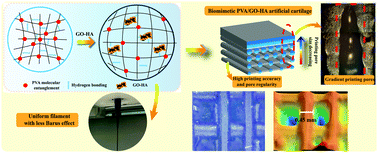3D printing of a poly(vinyl alcohol)-based nano-composite hydrogel as an artificial cartilage replacement and the improvement mechanism of printing accuracy
Abstract
Inspired by the gradient structure of articular cartilage, a poly(vinyl alcohol) (PVA)-based composite hydrogel with a biomimetic gradient structure as an artificial cartilage replacement was constructed by an extrusion 3D printing technique. The influence of the concentration and composition of the PVA-based solution on its rheological behavior and printability was studied, and the improvement mechanism for the 3D printing accuracy of the hydrogel was explored: introduction of GO or GO–HA gave rise to weakened inter-molecular hydrogen bonds and reduced entanglement density simultaneously, and the dynamic viscosity was highly improved. Therefore, the solution exhibited enhanced shear-thinning behavior in the printing shear rate range and a reduced Barus effect, thus highly improving the printability and printing accuracy of the samples. The 3D printing of PVA hydrogels was successfully achieved, and the printed biomimetic gradient samples possessed suitable compressive and tribological properties, which showed promising potential in the precise customized repair of artificial cartilage.

- This article is part of the themed collection: Journal of Materials Chemistry B Lunar New Year collection 2021


 Please wait while we load your content...
Please wait while we load your content...